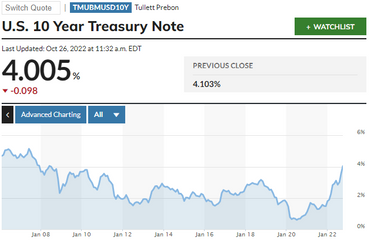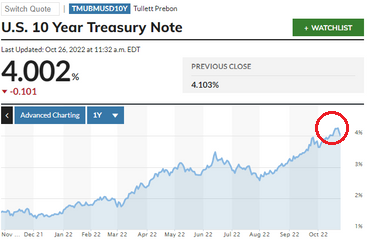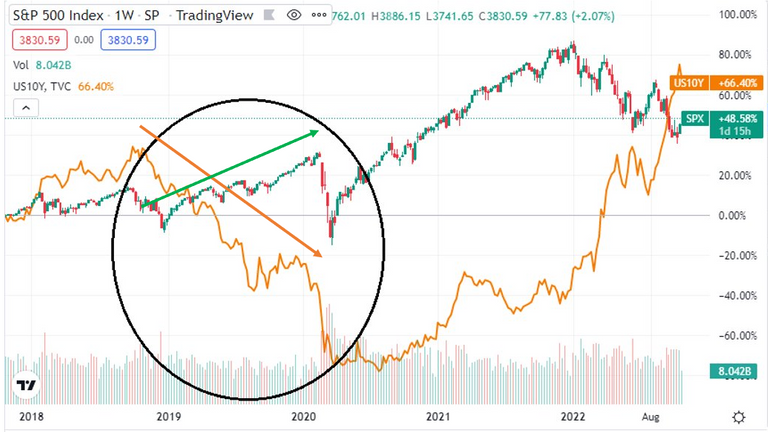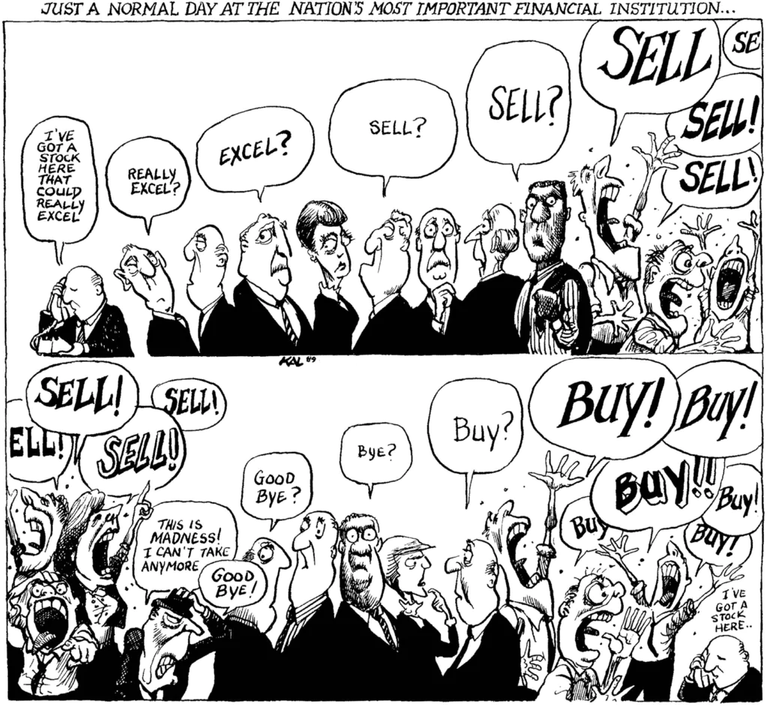Dear Hiveans,
today I'd just like to share my view on the current capital market.
My hypothesis for the coming 12 months:
- The inflationary pressures of the last 18 months led to higher interest rates which in turn led to demand destruction for credit, less consumption and a looming decline of company earnings.
- Inflation has peaked (or is very near its peak), as has the 10 year Treasury yield.


the declining yield (as a proxy for the discount rate) should lead to higher P/E ratios because
- Discounted Cash Flow model: the lower the discount rate, the higher the implied market capitalization of companies
- easier refinancing of companies (less debt payments)
- If the treasury yield goes down, the incentive to invest in stocks or crypto is higher.
The last time we had a yield curve inversion (December 2018) and the 10 year treasury yield started to decline, the stock market (S&P500) had an impressive run from around 2'500 to 3'300 (+32%) - until the Covid crash in March 2020 hit. A similar run would bring the S&P500 from currently 3'800 to 5'000.

So as long as company earnings do not decline unexpectedly, I expect a strong rebound of the stock and crypto market (stock market valuation = earnings x P/E ratio).
At some point in the next 12 months I expect a harsh recession to occur (early indicators are the inverted yield curve or the PMI), earnings to decline and the stock market to drop precipitously.
What do you think?
- Will we see a substantial rallye?
- How long will it last?
- How high will the S&P500 or Bitcoin go?
- What kind of stock market crash will follow?

Have a great day,
zuerich
Liebe Hiver,
heute möchte ich kurz meine Sicht auf den aktuellen Kapitalmarkt mit Euch teilen.
Meine Hypothese für die kommenden 12 Monate:
- Der Inflationsdruck der letzten 18 Monate führte zu höheren Zinsen, was wiederum zu einer Zerstörung der Nachfrage nach Kredit, zu weniger Konsum und einem drohenden Rückgang der Unternehmensgewinne führte.
- Die Inflation hat ihren Höhepunkt erreicht (oder steht kurz davor), ebenso wie die Rendite der 10-jährigen Staatsanleihen.


Die sinkende Rendite für "sichere" US-Staatsanleihen (als Proxy für den Diskontsatz) sollte zu einem höheren Kurs-Gewinn-Verhältnis bei Aktien führen, weil
- Discounted-Cashflow-Modell: je niedriger der Diskontsatz, desto höher die implizite Marktkapitalisierung der Unternehmen
- leichtere Refinanzierung von Unternehmen (weniger Kreditzahlungen)
- Wenn die Rendite der Staatsanleihen sinkt, ist der Anreiz, in Aktien oder Kryptowährungen zu investieren, höher.
Das letzte Mal, als wir eine Inversion der Zinskurve hatten (Dezember 2018) und die 10-jährige Treasury-Rendite zu sinken begann, hatte der Aktienmarkt (S&P500) einen beeindruckenden Lauf von etwa 2'500 auf 3'300 (+32%) - bis der Covid-Crash im März 2020 einsetzte. Ein ähnlicher Lauf würde den S&P500 von derzeit 3'800 auf 5'000 bringen.

Solange also die Unternehmensgewinne nicht unerwartet zurückgehen, erwarte ich einen starken Rebound des Aktien- und Kryptomarktes (Börsenbewertung = Gewinn x Kurs-Gewinn-Verhältnis).
Irgendwann in den nächsten 12 Monaten erwarte ich eine harte Rezession (Frühindikatoren sind die inverse Zinskurve und der PMI), einen Gewinnrückgang und einen steilen Einbruch des Aktienmarktes.
Was meint Ihr dazu?
- Werden wir eine starke Rallye erleben?
- Wie lange wird sie andauern?
- Wie hoch wird der S&P500 oder Bitcoin steigen?
- Welche Art von Börsenkrach wird folgen?

Have a nice day,
zuerich
Queridos Hiveanos,
hoy me gustaría compartir mi opinión sobre el mercado de capitales actual.
Mi hipótesis para los próximos 12 meses:
- Las presiones inflacionistas de los últimos 18 meses condujeron a una subida de los tipos de interés que, a su vez, provocó una destrucción de la demanda de crédito, un menor consumo y un inminente descenso de los beneficios de las empresas.
- La inflación ha tocado techo (o está muy cerca de él), al igual que el rendimiento del Tesoro a 10 años.


El descenso del rendimiento (como indicador del tipo de descuento) debería conducir a un aumento de los ratios de PER porque
- Modelo de flujo de caja descontado: cuanto menor sea el tipo de descuento, mayor será la capitalización de mercado implícita de las empresas
- se facilita la refinanciación de las empresas (menos pagos de deuda)
- Si el rendimiento del tesoro baja, el incentivo para invertir en acciones o criptografía es mayor.
La última vez que tuvimos una inversión de la curva de rendimiento (diciembre de 2018) y el rendimiento del tesoro a 10 años comenzó a bajar, el mercado de valores (S&P500) tuvo una carrera impresionante de alrededor de 2'500 a 3'300 (+32%) - hasta que el choque de Covid en marzo de 2020 golpeó. Una carrera similar llevaría al S&P500 de los 3'800 actuales a los 5'000.

Así que mientras los beneficios de las empresas no disminuyan de forma inesperada, espero un fuerte rebote del mercado de acciones y criptomonedas (valoración bursátil = beneficios x ratio P/E).
En algún momento de los próximos 12 meses espero que se produzca una dura recesión (los primeros indicadores son la curva de rendimiento invertida o el PMI), que los beneficios disminuyan y que la bolsa caiga estrepitosamente.
¿Qué opina usted?
- ¿Veremos un repunte sustancial?
- ¿Cuánto durará?
- ¿Hasta dónde llegará el S&P500 o el Bitcoin?
- ¿Qué tipo de caída bursátil se producirá?

Que tengan un buen día,
zuerich
Geht es nach Michael Burry steht uns demnächst die Mutter aller Crashes bevor. Er hat alle seine Aktien verkauft und nur eine Aktie behalten und aufgestockt. GeoGroup betreibt privat Gefängnisse in den USA und anderen Ländern. Ahnt der wieder etwas oder ist er zu pessimistisch?
Danke für deinen Kommentar!
Burry lag bisher meistens falsch. Aber ich rechne auch mit einem grossen Crash, allerdings erst nach einem Melt-up.
My understanding of finance is not very good. I hope one of your predictions is right:
😃
And the other is wrong:
A question (maybe several in one):
Do you expect the recession to be global? Will it affect certain parts of the world more severely? If the war situation gets worse, are all bets off and we have no idea what will happen. (That is my understanding of war: no winners, just loss and chaos).
Thanks for an interesting post.
Thank you for your comment!
Yes, I expect a global recession, with some countries to suffer more and others less. Energy-poor and/or export/import-reliant countries as Germany, China or Japan could do worse than the US or France.
And yes, the development of the war is highly unpredictable and could make everything worse 🫤
Zwar geben die Zinsen auf die 10-jährigen und die 30-jährigen aktuell etwas nach, aber das kurze Ende der Zinskurve steigt unaufhörlich weiter. Die jährlichen Zinsen auf die Eurodollar sind aktuell bei 5.10% und das bei einer maximalen Laufzeit von 90 Tagen.
Definitiv ein Warnsignal, das nicht zu verachten ist.
Der Eurodollar-Future war schon in der Vergangenheit immer das genaueste Barometer.
Andererseits zeigt die erwartete Schwankungsbreite (1 Standardabweichung) bis Dezember nächsten Jahres in den Optionsmärkten von 3100-5050 im S&P 500 Index einen klaren Call Skew, d.h. die Optionsmärkte sehen ein höheres Risiko nach oben als nach unten, was für Aktienindizes sehr selten ist. Normalerweise herrscht Put Skew vor.
Offensichtlich erwarten die Märkte, dass sich die Krise irgendwann nächstes Jahr auflöst.
Eurodollar sind ja keine echten Dollars.
Eine Währung kann ja ihren Währungsraum nicht verlassen. Die echten Dollar liegen ja in den USA. Normalerweise ist zwischen der Fed Funds Rate und den Zinsen auf die Eurodollar kein großer Unterschied.
Außer in Krisensituationen.
Momentan herrscht wegen der hohen Energiepreise ein Dollarmangel in Europa.
Der hohe Dollarkurs wird immer mehr zum Problem und wird eine Pleitewelle nach sich ziehen.
All das bildet der Eurodollar Future ab.
Definitiv der wichtigste Börsenindikator.
Dear @zuerich!
I have a hard time fully understanding your argument!
However, I agree with the argument that the economic situation will get worse in the future.
The world I live in is already mimicking China's communist economy.
😂😂 I think the cartoon was really funny. The inflation rate is a bit scary right now😂.
I think recession will go even further
Dein Wort in Gottes Ohr.
Me a causado mucha risa su última imagen porque aunque parece un chiste la realidad lleva mucho de eso. Yo creo que puede haber un pequeño repunte pero no será tan fuerte sino hasta 2025, pero eso es solo intuición que proviene del comportamiento del mercado cripto los úlitmos 12 años, sin embargo comparado con sus argumentos es nada ya que usted investiga y presenta argumentos muy sólidos y considerables. En cualquier caso y por beneficio de todos esperemos que un rally alcista inicie lo antes posible 😀
Sí, yo también espero que no veamos una gran recesión y mercados bajistas, pero soy escéptico.
I believe that with all the uncertainty in the world many countries and people will turn to crypto to fight inflation and mistrust in their governments. We already see mass regulation like in UK and this will only lead to faster adoption and usage. Probably 2023 will be a good year for crypto and while we might not have a bull run, the assets should only consolidate and softly appreciate.
Denke auch eine Zwischenrallye könnte durchaus drin sein. Aber für eine nachhaltige Erholung werden wir wohl noch etwas warten müssen. Krypto sehe ich erst 2024 neue ATH. Bei Aktien kommt es sehr auf die Branche an.